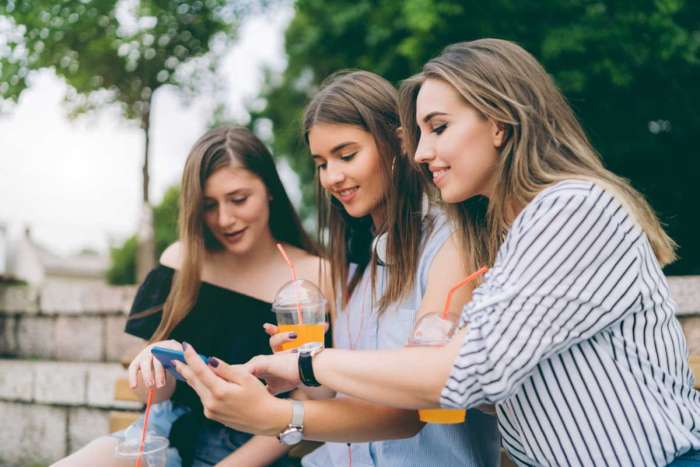If your teen is spending time on her phone, there’s a very good chance that she’s watching YouTube. As a source of entertainment and information, YouTube offers enticing reasons to visit and stay visiting for endless amounts of time. If you have a child with a phone or access to the internet, here is what you need to know about YouTube.
More: 5 Warning Signs of Screen Addiction
What Is YouTube?
YouTube is a video-sharing service. You can upload your own videos, watch other people’s videos, and interact with them by liking, sharing, and commenting. YouTube has been around since 2005, so it is firmly ingrained in the lives of most people who spend time online, particularly young people. YouTube also offers YouTubeTV as a streaming service similar to Hulu or Netflix.
Don’t have time to read now? Pin it for later:
Why is YouTube So Popular with Teens and Young People?
Teens enjoy viewing various kinds of videos on YouTube such as comedy shows, music videos, how-to guides, hacks, recipes, and more. Teens also tend to follow video bloggers known as vloggers. These vloggers often achieve celebrity status in the world of teens simply by posting videos. As Kyle, age 14 explains, “I like YouTube because it has entertaining videos on a wide variety of topics. I also like hearing various people giving their perspectives on various topics.”
The Ultimate Guide to Your Daughter's First Date (for Dads)
“Daddy’s little girl” — it’s an expression, of course, reflecting the special bond some fathers have with their daughters. As witnessed by actor Steve Martin’s freakouts in the classic 90s remake movie Father of the Bride, no dad wants to see his little girl married off; no longer the hero in her life. I know my husband will forever see our daughters as little girls no matter what. Read More
Viewers can even subscribe to specific YouTube channels that match their interests and follow celebrities. For example, Sariah*, age 13, enjoys watching the YouTube channel, The Norris Nuts, when friends come over. These are highly produced videos from an Australian family where they challenge each other to do silly things. Sariah and her peers, who are in the age range of 12 to 13, use these videos as inspiration to perform their own silly challenges with each other. In this way, YouTube can be a motivation for young people to be creative off-screen either with a group or on their own as they learn new skills or find inspiration for fun.
Using YouTube as a source of educational information is a popular benefit for all ages. As a parent, you may have searched for videos for anything from how to unclog a drain to how to bake a cake. Similarly, children and teens do the same. Laney, age 11, shared, “I like to watch YouTube because some videos can teach you about things.” Having both a visual and audial way to learn something makes taking in new information easier for many people, particularly because there are so many different kinds of learning styles and simply reading directions is not always the most effective way for everyone to learn. For example, many family board games or new appliances will now even list a link to a video within their instruction manual to provide an alternative option for learning the associated directions.
Can Teens Form an Emotional Connection with YouTube?
In addition to inspiration, YouTube can be used for purely entertainment purposes. When teens need a laugh, YouTube is one of the first places they turn to. Ethan, age 13, shared that the primary reason he uses YouTube is because it makes him laugh. He enjoys finding memes or funny videos and typically spends about 30 minutes doing this after completing homework on weekdays. This is a common way for teens to reward themselves after getting tasks done and also for the purpose of needed escapism.
Family Education expert Colleen Wildenhaus, founder of Founder of Good Bye Anxiety, Hello Joy - Parenting an Anxious Child, addresses this escapism:
"Teens can use YouTube as a way to escape the real world. Rather than addressing their personal thoughts and feelings, they hide or ignore them, as they get lost in the never-ending cycle of YouTube videos. This allows teens an opportunity to escape the pressures today’s teens face. The feelings teens experience while on YouTube are more pleasant than the feelings brought on by reality."[1]
While teens can use YouTube as a stress reliever, there may be more negative consequences as it can prevent them from actively learning to manage their stress without distraction. The need to escape stress and strong emotions as a teen is compelling. There are not many parents who haven’t taken the opportunity to binge-watch their own TV shows as a way to let off some steam, so it is understandable that children would find a way to do the same. As Ryan, age 17, shares, “YouTube is an outlet for me. It lets me forget about the world and all my stress and problems for a little while.”
How Can YouTube Negatively Impact Teens?
YouTube offers options for both creating and consuming. When there is an emphasis on consumption and teens spend too much time on YouTube, there can be negative implications.
As Family Education’s Teen expert Blaire Lent, founder of The Complete Student, a private school for middle and high school children explains:
“YouTube can be a fun option for teens, but there are some inherent dangers. There is little to no oversight about content and the program encourages users to lose track of time by continually offering more and more content that is semi-related to the original content viewed. Teens, and adults, can find that what began as a one-minute video, has mindlessly turned into 30 minutes of continuous videos that are increasingly less related to the original content. The danger for teen users is that they will be exposed to videos that are inappropriate without requesting access to such material. What may begin innocently can easily end inappropriately."[2]
YouTube is definitely a time-sucker due to the nature of its format. It’s nearly impossible to sit down and just watch one video. As Cooper, age 13, explains, “I like to watch YouTube because it is interesting, funny, and you get to learn a lot. Also, there are tons of YouTube holes you can go down to find millions of videos on a certain subject.”
These YouTube holes can be extremely challenging for young people to navigate. It’s hard to stop watching when a related video automatically begins playing as the one you are watching ends. There are also suggested videos listed along the sidebar while a video plays as well. With so many choices and with the temptation to keep watching so blatantly displayed, it would be hard to expect teens to be able to set their own limits and self-regulate the emotional needs that YouTube is fulfilling at the moment.
YouTube also offers videos that parents may deem inappropriate for their children. Violence, explicit language, and sexual content may be part of certain videos. Also, even without these factors, parents might not be happy with the vloggers their teens may choose to idolize and follow.
In addition, there is the concern about the digital footprint that teens may be leaving behind. If young people are uploading their own content to YouTube, it can be hard to erase the ramifications of poor judgment. The pressure to achieve viewers, likes, shares, and comments can also create a disturbing level of stress and anxiety for teens as content creators.
How Can Parents Decrease the Potential for Negative YouTube Experiences?
Although parents can certainly not monitor the YouTube usage of teens at all times as teens need to experience trust and independence on certain levels, there are steps that parents can take to contribute to a more positive YouTube experience for their children:
- Set parental controls. Although teens can most likely figure out how to undo parental controls, you can support these actions with conversations about why they are important.[3]
- Talk to your teen about YouTube, and regularly ask questions about what they are watching and creating. Parents can even watch favorites with their teens to show their interest and to let their children know that they care about the time that is being spent on YouTube.
- Set limits on technology time. For teens, it can be helpful to limit or remove technology from the room during homework time and bedtime. If technology is necessary for homework, parents can ask teens to use phones, laptops, and tablets in communal family spaces within the house. Limits help to decrease both depression and loneliness associated with too much time on technology and social media.
Having regular family discussions about how everyone in the family can be more intentional with their technology time is essential. Following YouTube and social media outlets that are positive, uplifting, and informative and choosing to avoid videos and content that do the opposite is extremely important in this digital age. As consumers in a digital world, establishing and regularly discussing family values associated with technology use and our digital footprints is helpful for all members of the family, especially teens.
*Starred names have been changed when teens do not wish to provide their real names.
Concerned about what your kids are doing online? Check out our Complete Guide to Digital Citizenship.



